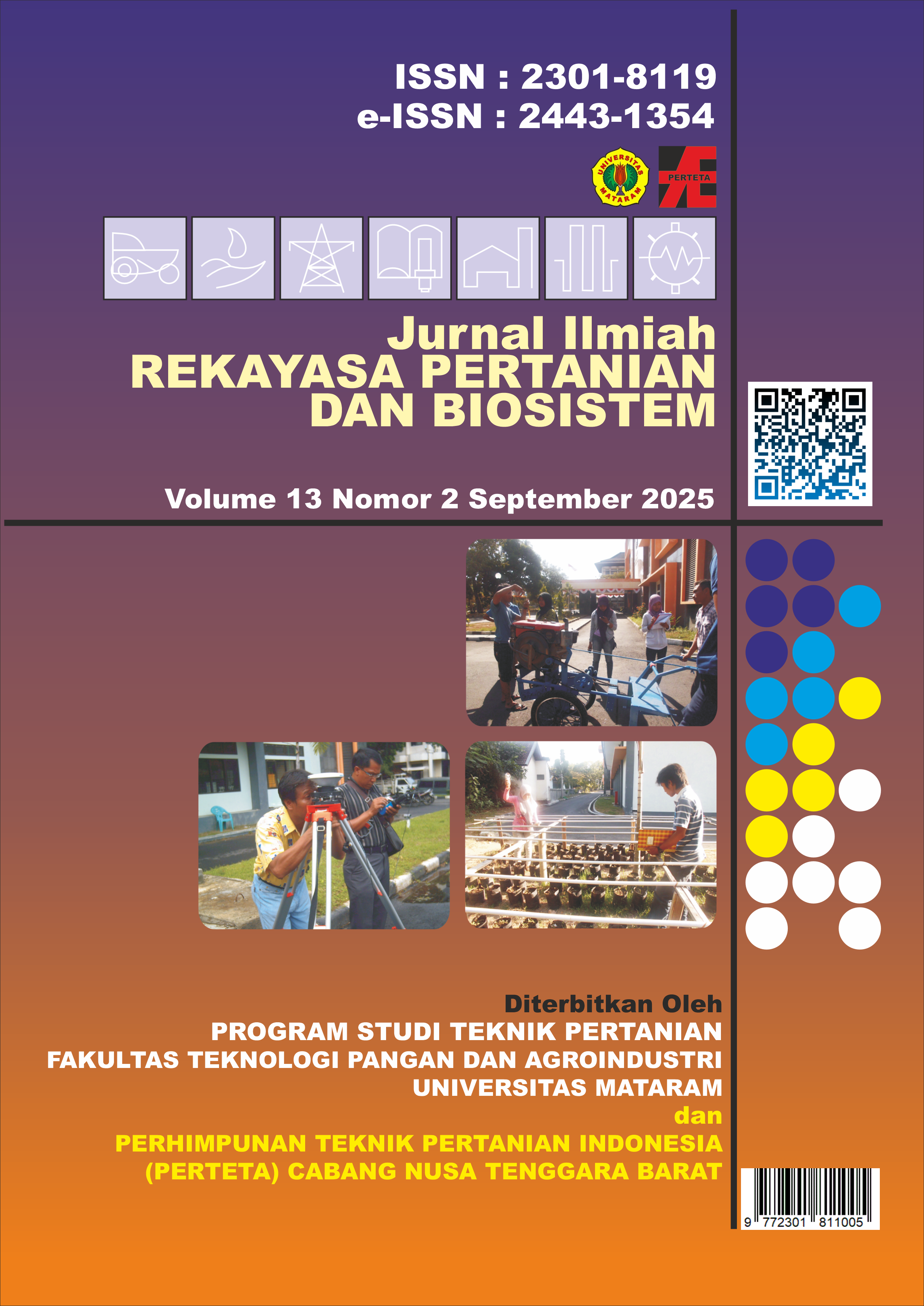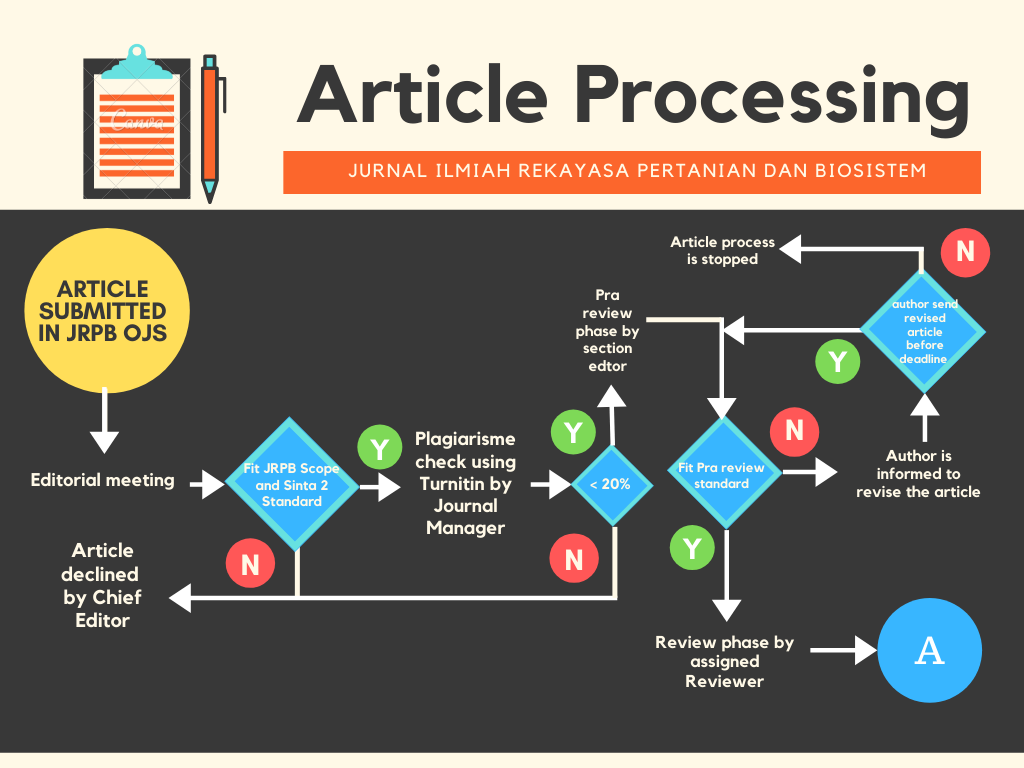Monitoring The Crowns of Palm Oil Plants in Central Lampung Regency using Remote Sensing Techniques
Authors
Ridwan Ridwan , Elhamida Rezkia Amien , Sandi Asmara , Ahmad Tusi , Faadiyah Nurul Azmi , Ilham Nur SyamtoDOI:
10.29303/jrpb.v13i2.1189Published:
2025-09-29Issue:
Vol. 13 No. 2 (2025): Jurnal Ilmiah Rekayasa Pertanian dan BiosistemKeywords:
monitoring, palm oil plants, remote sensingArticles
Downloads
How to Cite
Downloads
Abstract
Crude palm oil (CPO) productivity in Central Lampung Regency, at 2.25 tons/ha/year, remains below the national average of 3.90 tons/ha/year. One of the contributing factors is that oil palm plants are not growing optimally. This is reflected by the fact that the canopy cover is not dense or uniform. The objective of this study was to assess the dense or crown of oil palm trees using remote sensing technology from satellite imagery. In this study, Sentinel-2 imagery was used to oil palm canopy closure, and Landsat 8 imagery was used for land suitability analysis. The research method includes the vegetation index analysis by Normalized Difference Vegetation Index (NDVI), land moisture index by the Normalized Difference Moisture Index (NDMI), Land Surface Temperature (LST), and land suitability parameters. The results of the analysis are then macthed with the conditions of oil palm plants in the field. The results obtained from this study indicate that oil palm plantations in the Bekri District can be categorised into two discrete classes: Class S2 (sufficiently suitable) and Class S3 (marginally suitable). The total area encompassed by these classes is 8,903 hectares, with Class S2 covering 7,615 hectares and Class S3 covering 218 hectares. Moreover, the study revealed that 3,721 hectares were conducive to optimal plant growth with a dense crown, 765 hectares exhibited normal crown and growth, and 310 hectares displayed suboptimal growth with an indicated uniform dense crown. The overall accuracy rate of the study is 81.82%. There is a positive correlation between NDVI and NDMI values with a correlation coefficient (R2) of 0.8426, but there is a negative correlation between the NDVI and LST values with a correlation coefficient of -0.586.
References
Arini, Dwi., Sari, Silvina Mayang., Driptufany, Dwi Marsiska. 2022. Utilization of Landsat
Imagery to Detect the Health Level of Oil Palm Plants Using the Normalized
Difference Vegetation Index (NDVI) Method in Bengkalis Regency, Mandau
District. El-Jughrafiyah Scientific Journal. Vol. 02 Issue 02 Year
DOI:10.240/jej.v2i2.18744
https://www.researchgate.net/publication/363184361
Briany, AD., Ridwan., Amien, ER., Asmara, S. 2025. Analysis of Soil Surface Temperature
and Soil Moisture Using Landsat 8 OLI Image Interpretation at PT Great Giant
Pineapple Plantation. Journal of Agricultural Biosystem Engineering. Vol. 4 No.
/2025 DOI: http://dx.doi.org/10.23960/jabe.v4i1.10722 DOI: https://doi.org/10.23960/jabe.v4i1.10722
https://jurnal.fp.unila.ac.id/index.php/ABE/index
Central Bureau of Statistics of Lampung. 2023. Plantation Crop Area by Regency/City and
Type of Crop in Lampung Province (thousand ha). Accessed from
GAPKI. 2024. Get to Know More About Oil Palm: “What is an Oil Palm Tree and its
Characteristics?” Accessed from https://gapki.id/news
Geospatial Information Agency. 2014. Head of Geospatial Information Agency Regulation
Number 3 of 2014 on Technical Guidelines for Geospatial Data Collection and Processing.
Geospatial Information Agency. Cibinong. https://www.google.com/search
Li, W., Fu, H., Yu, L. and Cracknell, A. 2016. Deep learning based oil palm tree detection
and counting for high-resolution remote sensing images. Remote Sensing. 2017,
(1), p.22.; https://doi.org/10.3390/rs9010022 DOI: https://doi.org/10.3390/rs9010022
Palm Oil Plantation Fund Management Agency (BPDPKS). 2021. Growing Requirements
and Land Suitability for Oil Palm Plantations. Website:
https://www.bpdp.or.id/kesesuaian-lahan-untuk-perkebunan-kelapa-sawit
Pangestu, N. H. A., dan Banowati, G. 2023. Mapping the Health of Oil Palm Plantations
Based on Normalized Difference Vegetation Index (NDVI) Values Using Landsat-8
Imagery at PT. Wanapotensi Guna Plantation. Agriprima Journal. 7 (1). 40-49.
DOI: 10.25047/agriprima.v7i1.513 DOI: https://doi.org/10.25047/agriprima.v7i1.513
https://agriprima.polije.ac.id/index.php/journal/article/view/v7i1-d
Rahaldi, P., Hapsari, H., dan Wibowo, A. 2015. Analysis of Rice Plant Health Based on
Normalized Difference Vegetation Index (NDVI) Value Using Aster Image (Case
Study: Indramayu Regency - West Java). GEOID. 8 (2). 107-117.
DOI: 10.12962/j24423998.v8i2.270
https://www.researchgate.net/publication/307797283
Rahmah, IZ., Prasetyo, Y., Bashit, N. 2024. Analysis of Soil Moisture Level Distribution on
Rice Fields in Pati Regency Using Landsat 8 and 9 Images. Journal of Geography
Communication Media. Vol. 25 (1) pp. 53-65.
DOI: https://doi.org/10.23887/mkg.v25i1.70058 DOI: https://doi.org/10.23887/mkg.v25i1.70058
https://ejournal.undiksha.ac.id/index.php/MKG/article/view/70058
Rozenstein, O., Qin, Z., Derimian, Y., dan Karnieli, A. 2014. Derivation of land surface
temperature for landsat-8 TIRS using a split window algorithm. Sensors. MDPI
Journal. Switzerland. 14(4). 5768–5780. DOI: https://doi.org/10.3390/s140405768 DOI: https://doi.org/10.3390/s140405768
https://www.mdpi.com/1424-8220/14/4/5768
Sakinah, FM., dan Prarikeslan, W. 2024. Mapping Analysis of Identification of Plant Health
Conditions and Productivity of Oil Palm Plants in Each Afdeling of Plantation 3 PT.
JATIM Jaya Perkasa, Rokan Ilir Regency. Tambusai Education Journal. DOI:10.31004/jptam
https://jptam.org/index.php/jptam
Sarwono, J. 2006. Quantitative and Qualitative Research Methods. Yogyakarta: Graha Ilmu.
Website https://id.scribd.com/document/738747716
Stathopoulou, M and Cartalis, C. 2007. Daytime urban heat island from Landsat ETM+ and
Corine land cover data: An Aplication to major cities in Greece. Solar Energy Vol.
(3), March 2007, p.358-368. https://doi.org/10.1016/j.solener.2006.06.014 DOI: https://doi.org/10.1016/j.solener.2006.06.014
Yulistriani., Paloma, C., Hasnah. 2017. Identification of Factors Affecting Community Oil
Palm Management in Dharmasraya District, West Sumatra. Proceedings of the
National Seminar on Suboptimal Lands 2017. Palembang October 19-20,
http://repo.unand.ac.id/14122/1/Prosiding_UNSRI.pdf
Yuniasih, B., dan Adji, ARP. 2022. Evaluation of Oil Palm Plantation Condition Using
NDVI Index from Sentinel 2 Satellite Image. Vol. 16 No. 2 Year 2022.
DOI: 10.24198/jt.vol16n2.10 https://jurnal.unpad.ac.id/teknotan/ DOI: https://doi.org/10.24198/jt.vol16n2.10
Yurianda, RB., Styawan, D., Warsito. 2022. Normalized Difference Vegetation Index
Classification Method Based on Landsat 8 Image to Identify the Distribution of Oil
Palm Plant Health Conditions at PT. Andira Agro, South Sumatra.
PEDONTROPIKA Journal of Soil Science and Land Resources. Vol 8 No. 2 Page.
DOI : pedontropika.v8i2.56431
https://jurnal.untan.ac.id/index.php/pedontropika/article/view/56431
License
Copyright (c) 2025 Ridwan Ridwan, Elhamida Rezkia Amien, Sandi Asmara, Ahmad Tusi, Faadiyah Nurul Azmi, Ilham Nur Syamto

This work is licensed under a Creative Commons Attribution-ShareAlike 4.0 International License.
Authors who publish with this journal agree to the following terms:
- Authors retain copyright and grant the journal right of first publication with the work simultaneously licensed under a Creative Commons Attribution License 4.0 International License (CC-BY-SA License). This license allows authors to use all articles, data sets, graphics, and appendices in data mining applications, search engines, web sites, blogs, and other platforms by providing an appropriate reference. The journal allows the author(s) to hold the copyright without restrictions and will retain publishing rights without restrictions.
- Authors are able to enter into separate, additional contractual arrangements for the non-exclusive distribution of the journal's published version of the work (e.g., post it to an institutional repository or publish it in a book), with an acknowledgement of its initial publication in Jurnal Ilmiah Rekayasa Pertanian dan Biosistem (JRPB).
- Authors are permitted and encouraged to post their work online (e.g., in institutional repositories or on their website) prior to and during the submission process, as it can lead to productive exchanges, as well as earlier and greater citation of published work (See The Effect of Open Access).










